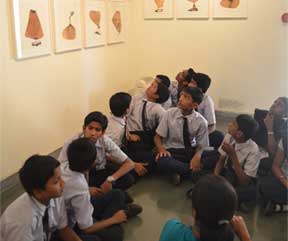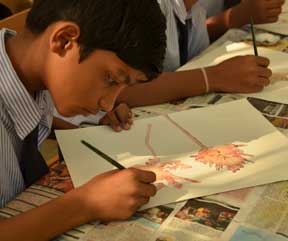Epiphanies showcased new and recent works by the New Delhi based artist Manisha Parekh. Parekh’s oeuvre straddles painting, collage and drawing. Working with handmade paper and organic material, she creates minimal works whose innate energy recalls natural rhythms and biomorphic forms. Her artistic practice also draws upon craft and textile traditions. In Epiphanies, Parekh presented a site specific installation of jute sculptures and a suite of graphite drawings among other works.
Every act of art making is political.
Manisha Parekh’s ink bleeds across the surface of the paper in abstract forms. Rubbing, perforations and ink drips recall the desire to move beyond the paper surface, while the jute sculptures are intricately modeled, looped and tied.
The artist’s automatic techniques underlie any apparent precision and return the works to their genesis in the unconscious. Intimate and sensual, the forms on paper and in wood, take on the shapes of nature, the organic and passing effects of the atmosphere. Nature transforms in her hands, as birchwood becomes ‘clouds.’
The craft involved in the deft and painstaking making of the works emerges out of the seductive rapport between artist and material found in the hours spent in shaping line and form; the rhythm and phrasing similar to the careful attention Japanese poets paid to each haiku. Such poetry may belie the work’s political intent.
Like the Impressionists, who sought to move beyond the photograph in the nineteenth century,Parekh finds beauty in nature, the ephemeral and the strength and spontaneity of her hand to subvert and elude technology. At the same time, as seen in the laser-cut wood, she begins to make use of such possibilities reflecting the society in which she lives.
The artist’s focus on the local and on raw materials used frequently in her work reveal a surprising history of British colonial expansion and trade—tea, jute, cotton—which relive India’s recent past while creating new, artistic lineages with once exploited commercial goods that become a quiet act of political resistance.
A daughter of painters and a student of Baroda in the 1980s, Parekh was influenced by a post-colonial legacy of oil painting and narrative figuration, but the artist lightened this burden by omitting the figure, turning instead to the composition and craft of narrative. The latter shifts Parekh away from the pure minimalism with which she is so often associated.
Spaces, fragments, pauses, and ellipses become important in her story, as they vibrate and unsettle the material works. A new dynamic is thus created: woman, artist and aesthetic order.

Free, open to all tours of the exhibition in English, Hindi and Marathi were conducted by the Museum’s curatorial team every Sunday from January 25 – March 2, 2014

The workshop encouraged participants to engage with the artist’s practice of drawing with organic materials and create their own paintings using natural pigments like tea, coffee, turmeric and vegetable colours. This workshop was offered to schools, for students aged 6 and above, on request throughout the duration of the exhibition.
A free, open to public, session of this activity was conducted on Saturday, 15 February, 2014.